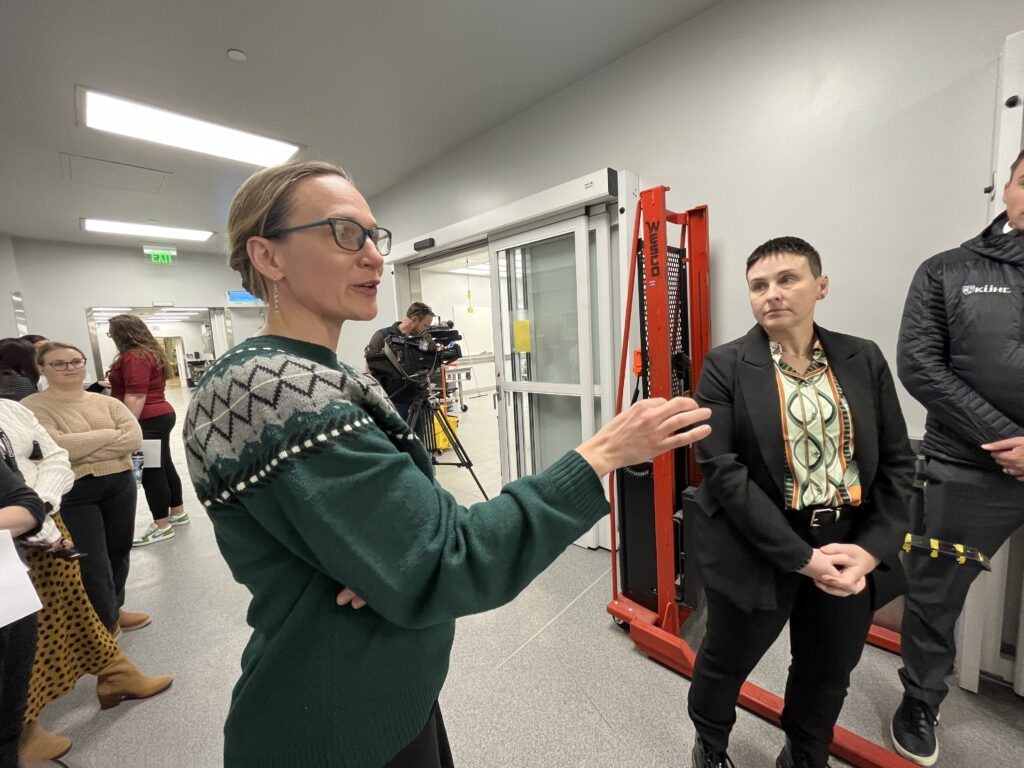
Chief Medical Examiner Deirdre Amaro (left) and Chief Medical Examiner Investigator Cory Russo (right) on a media tour of the Utah Office of the Medical Examiner on Nov. 14, 2024 (Alixel Cabrera/Utah News Dispatch)
Dr. Deirdre Amaro sometimes thinks about how her office is perceived by people who may not be familiar with death investigations.
Her workspace at the Utah Office of the Medical Examiner has some expected fluorescent lighting, cold hallways that connect coolers with the capacity to hold up to 12 or 70 bodies, and an overwhelmingly strong smell.
The office also has a full-scale X-ray machine adorned with large googly eyes and affectionately known as Larry, a model skeleton with its own employee ID, and a spreadsheet to divide the responsibility of watering the many plants placed on high window sills.
The Utah Office of the Medical Examiner, which Amaro has led since this summer, investigates all sudden, unexpected, violent, suspicious or unattended deaths in the state by conducting post-mortem exams and autopsies to explain the diseases or injuries that may have caused them. The office opened its doors to news organizations last week to show how this unique organization impacts Utahns.
Do they work with death because they’re a bunch of “awkward weirdos”? Partially, yes, Amaro said. However, more than 90% of their work, the part in which they collect data that is then reported to the U.S. Centers for Disease Control and Prevention, is aimed to help the living.
GET THE MORNING HEADLINES.
“Death certificate data becomes a reflection of the health of a community. We are literally seeing the terminal results of public health problems here. Drugs? That’s a problem that’s killing people. We see that here,” Amaro said. “And if we can understand what is killing people in our community and why, then maybe we can figure out how to prevent that. And that is what we are about, not just little goblins under the bridge.”

While CSI TV shows are cool, they are slightly inaccurate, Amaro said. Most people assume her team mostly investigates homicides, she said. In reality, the majority of their work focuses on manners of death; natural and accidents.
Natural deaths overseen by the office could be either an older person who wasn’t under the care of a physician for a long time and suddenly died, or a young athlete who suddenly collapsed on the field from an undiagnosed heart condition. And, accidents include car accidents and drug overdoses.
How these death investigations work in Utah is distinct, if compared to other states that have elected coroners, who aren’t necessarily required to be doctors or forensic pathologists. Utah has a centralized office with highly-trained physicians who must be licensed.
In Utah, according to the CDC, the leading causes of death are heart disease, cancer, accidents, Alzheimer’s disease, COVID-19, stroke, chronic lower respiratory diseases, diabetes, suicide and nutritional deficiencies.
Most cases the office gets, Amaro said, are natural manners of death, then accidents, then suicides, and below that is homicide.
“That’s pretty much the same across the nation,” she said.
Life at the office

The job at the Office of the Medical Examiner is often heavy. A doorbell alerts staff about 15 to 20 times a day when a new decedent is about to enter the building, and they often see the endline of someone’s death.
While it’s a daily occurrence, they don’t take their responsibility lightly.
“Going to someone’s house on the worst day of their lives, being able to really handle their emotions with care and really have empathy for those people on that worst moment, is really important to me,” chief medical examiner investigator Cory Russo said on Thursday. “And then to be able to come back and do the follow up work, whether that’s positive identification after someone has been missing for years, that is so rewarding, to be able to bring closure to families.”
Apart from 12 forensic pathologists, with some specialties including pediatrics and neuropathology, the Utah Office of the Medical Examiner has a team of forensic epidemiologists who focus on suicide, drug overdose and prevention efforts.
Suicide, for example, is one of the most predominant causes of death that the office sees. In 2022, Utah ranked 7th in the country for suicide mortality rates. The epidemiologists help the team make sense of that data.

“We can tell you this person died by suicide with a gun, but (epidemiologists) can tell you what were the circumstances around that death,” Amaro said. “So if we figure out the why, why are so many people in Utah killing themselves, then maybe we can fix that, and that’s what motivates me, and that’s what motivates most of us in this office.”
The facility also has a space dedicated for DonorConnect, a nonprofit that connects, with the authorization of families, tissue donors with recipients, including veins, long bones, skin and corneas, explained Brandon Callor, morgue operations manager at the state office.
“There’s a window of time (in which they) are still viable, and they can recover those tissues,” Callor said of the nonprofit. Whereas in other states, those tissues may have to travel hours, losing a lot of potential donors.
Apart from that service, another rewarding aspect of the job, Callor said, is the perspective it provides. Also a social worker, he said he finds purpose on interviewing people who have lost loved ones to suicide or drug overdose to determine solutions outside the autopsy suite, including advocating for legislation to help the public who may be at risk, and helping some families with their grief.
“I think I can’t feel sorry for myself for very long when I realized there’s so much suffering out there,” Callor said. “And so, being able to be involved in the aid of someone else’s suffering just helps me to gain that perspective and think outwardly.”
YOU MAKE OUR WORK POSSIBLE.

